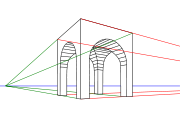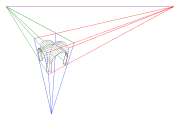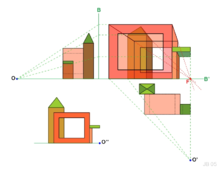Vanishing point

In a perspective illustration ( central projection ), the images of all straight lines that run parallel to one another in the original but are not parallel to the image plane intersect at a common vanishing point .
In perspective imaging, spatial objects are projected onto a flat surface, the image plane. This is the case, for example, when taking photographs. In the original picture [1], among other things, the road edges, roof lines and window lines of the built-up street are parallel straight lines: They all run towards a common vanishing point.
The vertical house edges are also parallel straight lines. However, their vanishing point is far outside the picture, in "infinity".
All parallel planes intersect in a common escape line. For the horizontal levels of the picture [1], such as the street surface and the floor ceilings, this is the horizon . The vanishing points of all parallels in such a plane lie on this straight line.
Illustration with three vanishing points ( bird's eye view )

In buildings in particular, there are mutually perpendicular lines in three directions: height, width, depth. The direction of view (recording direction of the camera, perspective ) for an image can be selected so that one, two or three vanishing points are created. This is known as the vanishing point perspective.
The perspective of an image leads the viewer's gaze to the vanishing point. The choice of the position and the number of vanishing points of an image are therefore an essential task of image design. Vanishing points create dynamism and spatial depth. They set accents and bring objects into the focus of the observer.
Geometric construction
The figure [3] shows the geometrical relationship between the vanishing point perspective and the parallel projection. The latter is used for measurable maps and plans. The projection of all object points from an eye point O onto an image area B for both the floor plan (O ', B') and the elevation (O, B) result in vertical and horizontal lines of intersection with the corresponding image points in the projection. The picture shows that the closer the eye point moves to the object, the stronger the dynamic. The position of the eye point not only determines the aspect angle, but also the visibility of object details.
If the image plane is parallel to an object surface, here the building front, this surface (as well as all surfaces parallel to it) has its vanishing points at infinity. In particular, all parallel straight lines that lie in a plane parallel to the image plane continue to be mapped in parallel. If the image plane B '(floor plan) is rotated, a vanishing point in the finite is also created for these surfaces. The result is a picture analogous to picture [2]. Tilting image plane B in elevation leads to either a bird's eye or a frog's eye view .
See also
Web links
- Thomas Gauck, Vanishing Point Lines in Photography
- Trigonometric calculation of vanishing points Presentation of the principle and brief instructions




